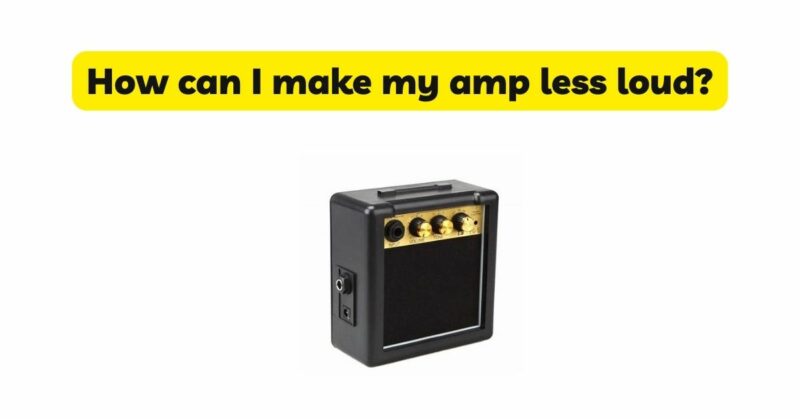Amplifiers are essential tools for musicians, allowing them to project their sound and create captivating performances. However, there are times when you may need to make your amplifier less loud. Whether you’re practicing at home, performing in a small venue, or seeking a more balanced sound, this article explores various techniques to help you achieve a lower volume without compromising tone and musicality. Join us as we delve into the world of amplifier control and discover how to make your amp less loud while maintaining a satisfying sonic experience.
Understanding Amplifier Volume: Before diving into the techniques for reducing amplifier loudness, it’s important to understand how volume is generated in amplifiers. Amplifier volume is primarily influenced by two factors:
- Gain and Preamp Settings: The gain control, often found on the amplifier’s preamp section, determines the level of amplification applied to the incoming signal. Higher gain settings lead to increased amplification and subsequently louder output volume. Adjusting the gain control can significantly impact the overall volume of the amplifier.
- Power Amplification: The power amplifier section of an amplifier further amplifies the signal from the preamp and delivers it to the speakers. The power rating of the amplifier and the volume control directly affect the loudness of the output. Reducing the power delivered to the speakers will result in lower overall volume.
Techniques for Reducing Amplifier Loudness: Here are several effective techniques for making your amplifier less loud:
- Gain Reduction: The most direct way to reduce amplifier loudness is by adjusting the gain control on the preamp section. Lowering the gain setting reduces the amount of amplification applied to the signal, resulting in a quieter output. Experiment with different gain levels to find the balance that maintains tone and musicality while achieving the desired volume reduction.
- Volume Control: Most amplifiers feature a volume control that allows you to adjust the overall output level. Lowering the volume control reduces the signal sent to the power amplifier, resulting in a quieter sound. However, be aware that simply lowering the volume control can affect the tonal characteristics and dynamic response of the amplifier, so it’s important to find the optimal setting that maintains the desired sound quality.
- Attenuators: Attenuators are devices designed to reduce the output volume of an amplifier while preserving the tone and dynamics. They are typically connected between the amplifier’s speaker output and the speaker itself. Attenuators provide a way to dial down the volume without sacrificing the natural breakup and response of the amplifier. These devices often offer adjustable attenuation levels, allowing you to find the perfect balance between volume reduction and desired tonal characteristics.
- Power Soaks: Power soaks, also known as power attenuators or load boxes, are similar to attenuators but typically operate between the amplifier and the speaker cabinet. They enable you to reduce the volume by dissipating excess power before it reaches the speaker. Power soaks are particularly useful for tube amplifiers, as they allow you to attain the desired tube saturation and tone at lower volume levels.
- Switchable Power Settings: Some amplifiers offer switchable power settings that allow you to adjust the power output to suit different environments. These settings typically reduce the power delivered to the speakers, resulting in lower volume levels while retaining the amplifier’s tone and response. Switchable power settings are commonly found in tube amplifiers and can be an effective way to achieve lower volume levels without compromising on tone.
- Speaker Selection: The choice of speakers can significantly impact the perceived volume of an amplifier. Speakers with lower sensitivity ratings require more power to reach the same volume level as speakers with higher sensitivity ratings. By selecting speakers with lower sensitivity, you can effectively reduce the overall volume of the amplifier without compromising on tone. It’s important to consider the tonal characteristics and efficiency of the speakers when making a selection.
- Isolation and Acoustic Treatment: Reducing the perceived volume of an amplifier can also be achieved by isolating it from the surrounding environment. Placing the amplifier on isolation pads or stands can help reduce vibrations that contribute to perceived loudness. Additionally, implementing acoustic treatment in your practice space or performance area can help control sound reflections and reduce overall volume. Absorptive panels, diffusers, or bass traps can create a more controlled sound environment and minimize the need for higher volume levels.
- Dynamic Playing Technique: Mastering your playing technique can have a significant impact on the perceived loudness of your amplifier. By employing a lighter touch, controlling your dynamics, and focusing on nuance and expression, you can achieve a quieter sound without relying solely on amplifier adjustments. This technique is particularly effective for guitarists and other instrumentalists who have control over their playing dynamics.
Conclusion: Reducing the loudness of your amplifier is achievable through various techniques and adjustments. By adjusting the gain and volume controls, incorporating attenuators or power soaks, utilizing switchable power settings, selecting speakers with lower sensitivity, employing isolation and acoustic treatment, and refining your playing technique, you can achieve lower volume levels without sacrificing tone and musicality. Experimentation and finding the right balance for your specific needs are key to achieving the desired volume reduction. Remember, making your amp less loud is not about limiting your sound but rather about finding the sweet spot that allows you to express yourself while respecting your environment and personal preferences.


